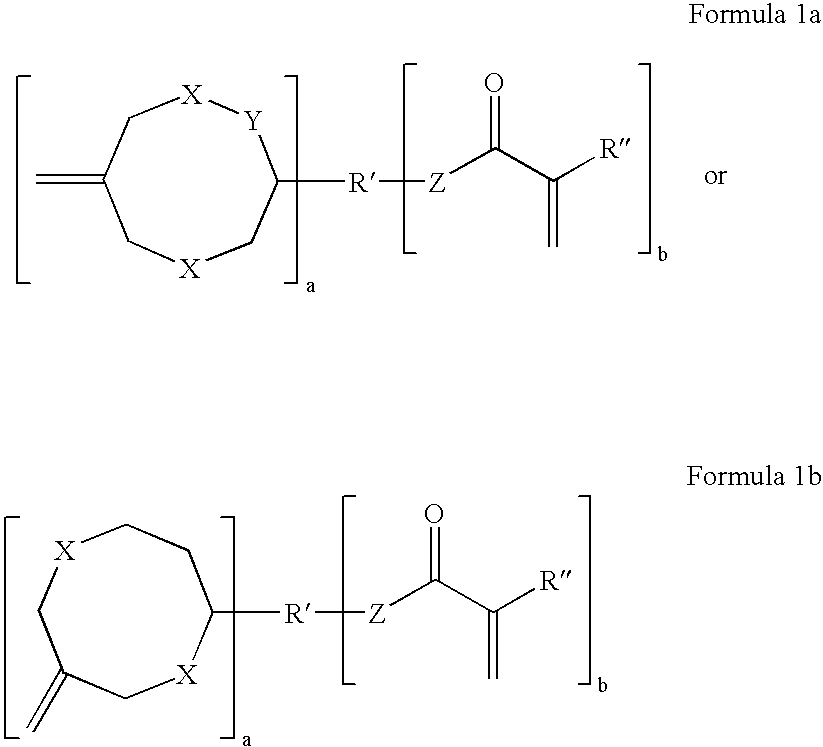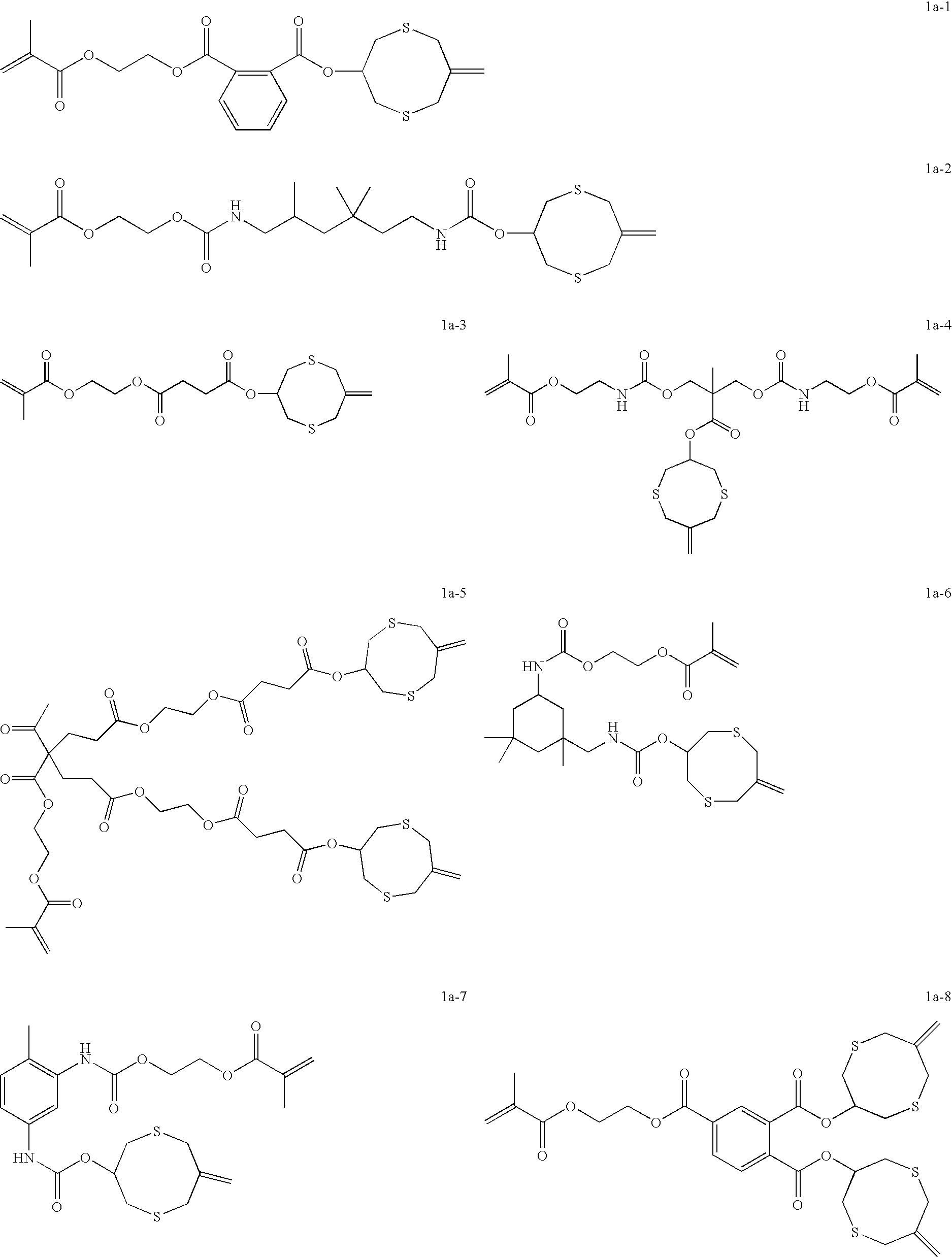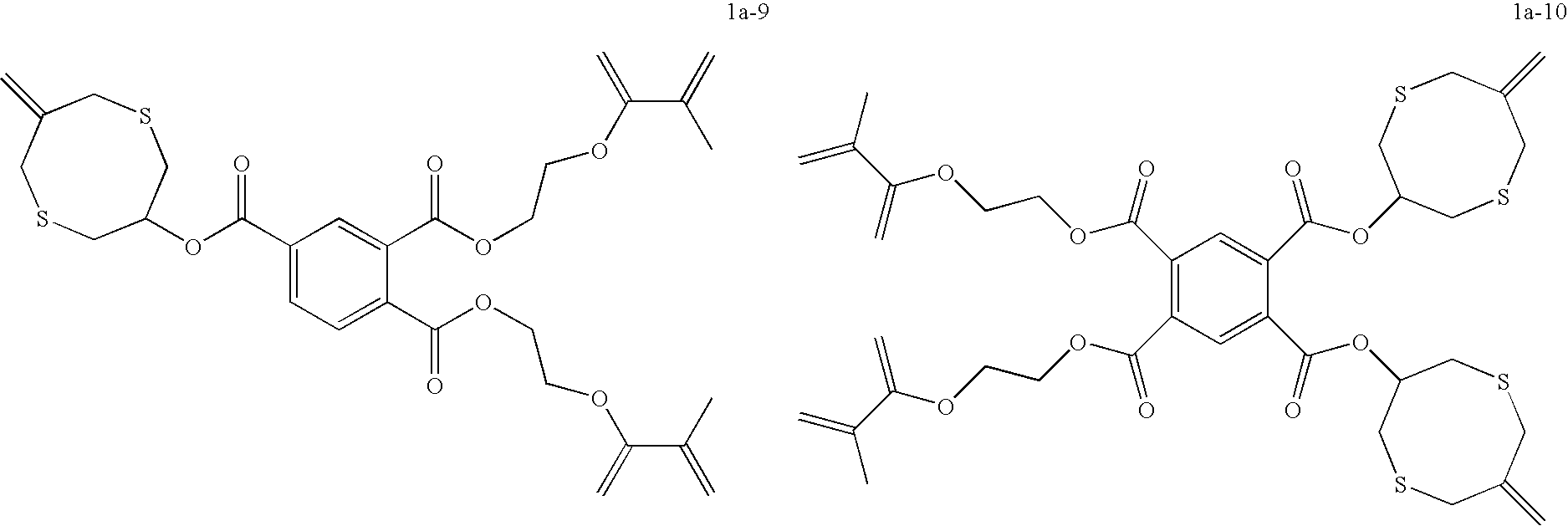Dental Compositions Containing Hybrid Monomers
a technology of hybrid monomers and dental compositions, applied in the field of hardenable dental compositions, can solve the problems of gap between the composite and the tooth structure, post-operative sensitivity, microleakage, secondary caries, etc., and many of the low-shrink compositions currently available lack the physical, mechanical, optical properties required for dental applications
- Summary
- Abstract
- Description
- Claims
- Application Information
AI Technical Summary
Benefits of technology
Problems solved by technology
Method used
Image
Examples
preparatory example 1
C-8 Diurethane
(1,6-Bis(7-methylene-1,5-dithiacyclooctan-3-yl)-2,4,4-trimethylhexane dicarbamate)
[0097]7-Methylene-1,5-dithiacyclooctan-3-ol (C-8 Alcohol; 2.9 g, 16 mmole) and dibutyl tin dilaurate (10 mg; Sigma-Aldrich) were dissolved in dry tetrahydrofuran (THF, 10 ml) under nitrogen. The resulting solution was heated to reflux and a solution of 2,4,4-trimethyl-1,6-diisocyanatohexane (1.76 g, 8.2 mmole) in dry THF (10 ml) was added dropwise. The reaction was monitored by thin layer chromatography (ether:methylene chloride 1:1) until the starting C8-Alcohol was consumed. (About 12 hours reaction time.) The solvent was then evaporated to give a viscous clear oil / gum. The oil / gum was purified by dissolving in methanol (15 ml per gram) to give a slightly milky solution. A small quantity of the gum separated. The solution was filtered into another flask and water (3 ml per gram) was added slowly to the filtrate with stirring. During the addition, a white residual material separated from...
example 1
1-(2-Methacryloyloxyethyl)-2-(7-methylene-1,5-dithiaoctan-3-yl) Phthalate
[0098]mono-2-Methacryloyloxyethyl phthalate (9.4 g, 31 mmole, Sigma-Aldrich) and C-8 Alcohol (5.38 g, 31 mmole) were dissolved in methylene chloride (50 ml) in a 3-neck flask equipped with a magnetic stirring bar and nitrogen gas inlet. DMAP (400 mg) was added and the resulting mixture was cooled in an ice bath for 20 minutes. To the cooled solution was added a solution of DCC (6.95 g, 34 mmol) in methylene chloride (50 ml). The addition was carried out dropwise over 1 hour while the flask contents were continuously stirred under nitrogen at 0° C. The resulting mixture was then stirred with the flask in the ice bath for 1 hour and then at room temperature overnight. The resulting precipitate was removed by vacuum filtration using a Buchner funnel with filtration aid celite. The filtrate was then washed once with 0.1 N HCl (100 ml), once with 5% NaOH (100 ml), and once with water (100 ml). The organic ...
example 2
1-(Methacryloyloxyethyl)-6-(7-methylene-15-thiacyclooctan-3-yl)-2,4,4-trimethylhexane Dicarbamate
Compound B
[0099]2,4,4-Trimethyl-1,6-diisocyanatohexane (17.6 g, 84 mmol) was dissolved in methylene chloride (100 ml) in a 3-neck flask equipped with a stirring bar and nitrogen inlet. To the flask was added dibutyl tin dilaurate (10 drops, Sigma-Aldrich) and to the continuously stirring solution was further added C-8 Alcohol in small increments (total added: 14.8 g, 84 mmol). The resulting mixture was stirred at room temperature for 6 hours during which time all of the C-8 Alcohol disappeared as monitored by thin layer chromatography (4:1 hexane:ethyl acetate, silica gel on glass plates). HEMA (10.92 g, 84 mmole) was added dropwise to the mixture and the disappearance of the isocyanato moiety (—NCO) was monitored by FT (Fourier Transform) IR spectroscopy. Stirring was continued overnight, after which IR indicated about 95% NCO reaction completion. Methanol (10 ml) was added and after 0...
PUM
| Property | Measurement | Unit |
|---|---|---|
| Nanoscale particle size | aaaaa | aaaaa |
| Volume | aaaaa | aaaaa |
| Shrinkage | aaaaa | aaaaa |
Abstract
Description
Claims
Application Information
 Login to View More
Login to View More - R&D
- Intellectual Property
- Life Sciences
- Materials
- Tech Scout
- Unparalleled Data Quality
- Higher Quality Content
- 60% Fewer Hallucinations
Browse by: Latest US Patents, China's latest patents, Technical Efficacy Thesaurus, Application Domain, Technology Topic, Popular Technical Reports.
© 2025 PatSnap. All rights reserved.Legal|Privacy policy|Modern Slavery Act Transparency Statement|Sitemap|About US| Contact US: help@patsnap.com



